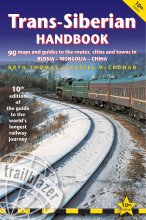Guides that will send you packing.
— Today

Trans-Siberian Handbook
Excerpt:
Introduction
Contents | Introduction | Individual itineraries or organised tours? | Route planning | What to take | Sample Route Guide: Trans-Siberian Route and map 1 | Other railway lines linked to the Trans-Siberian | Best of Trans-Siberian

INTRODUCTION
‘Best of all, he would tell me of the great train that ran across half the world ... He held me enthralled then, and today, a life-time later, the spell still holds. He told me the train’s history, its beginnings ... how a Tzar had said, ‘Let the Railway be built!’ And it was ... For me, nothing was ever the same again. I had fallen in love with the Traveller’s travels. Gradually, I became possessed by love of a horizon and a train which would take me there ...’
Lesley Blanch Journey into the Mind’s Eye
The spell that Lesley Blanch’s ‘Traveller’ cast captured me, too, as it has countless others. And after the classic film of Boris Pasternak’s love story, Dr Zhivago, there can be few people unaware of the magic and romance of crossing Russia and the wild forests and steppes of Siberia on the longest railway journey in the world – the Trans-Siberian. The distances spanned are immense: almost 6000 miles, a seven-day journey, between Moscow and the Pacific port of Vladivostok (for boat connections to Japan); just under 5000 miles, five days, between Moscow and Beijing.
Since the rail service linking Europe with the Far East was established at the turn of the 19th century, foreign travellers and adventurers have been drawn to it. Most of the early travellers crossed Siberia in the comfort of the carriages of the Belgian Wagon Lits company, as luxurious as those of the Venice-Simplon Orient Express of today. Things changed somewhat after the Russian Revolution in 1917 as it became increasingly difficult for foreigners to obtain permits for Siberia.
It was not until the 1960s that the situation improved and Westerners began to use the railway again for getting to Japan, taking the boat from Nakhodka (it now leaves from Vladivostok) for the last part of the journey. In the early 1980s travel restrictions for foreigners visiting China were relaxed and now many people have found the Trans-Siberian a fascinating and relatively cheap way to get to or from both China and Mongolia.
While the ending of the Cold War removed some of the mystique of travelling in the former USSR, Russia’s increasing accessibility means that there are new travel opportunities right across the country. With foreigners no longer obliged to stay in overpriced state-run hotels, visiting the country is more affordable than ever before.
Rail passengers inevitably absorb something of the ethos of the country through which they travel: on this train you are guaranteed to meet local people, for this is no ‘tourist special’ but a working service; you may find yourself draining a bottle of vodka with a Russian soldier, discussing politics with a Chinese academic, or drinking Russian champagne with a Mongolian trader.
In this jet age most of us have lost touch with the travel experience that is slow enough to give us a real concept of the geographical distance we’ve travelled. Quite apart from being environmentally unfriendly, to the 21st century traveller air travel has become mind-numbingly routine and unexciting. To embark on a long-distance rail journey, spending days on a train and traversing thousands of miles over the planet’s surface, is just as thrilling now as it was a century ago. As Eric Newby wrote in The Big Red Train Ride, ‘The Trans-Siberian is the big train ride. All the rest are peanuts’. Nothing can change that.
Trans-Siberian Handbook
Excerpts:
- Contents
- Introduction
- Individual itineraries or organised tours?
- Route planning
- What to take
- Sample Route Guide: Trans-Siberian Route and map 1
- Other railway lines linked to the Trans-Siberian
- Best of Trans-Siberian
Price: £16.99 buy online now…
Latest tweets